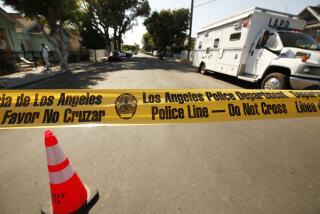The journey of LAPD’s anti-terror Suspicious Activity Reports
- Share via
For years, law enforcement agencies around the U.S. have been urging the public to keep an eye out for all things suspicious — packages, behavior, vehicles. In a post-9/11 world, the thinking goes, we all need to do our part to keep terrorists from striking again by alerting police of anything that seems out of place. “If you see something, say something,” say the billboards and subway posters.
But if you do see something, how exactly are you supposed to say something? There is, of course, 911 for emergencies. But in Los Angeles, people can also get online and file a Suspicious Activity Report, or a SAR for short.
This week the Los Angeles Police Commission’s inspector general released an audit of the LAPD’s handling of the reports. The report found no widespread problems but nonetheless reignited long-running criticisms that they infringe on privacy and are ineffective.
What happens when someone files a report?
The SAR form, which is available online, can be submitted anonymously. It asks people reporting to describe, among other things, what they saw and to identify the suspect if possible.
Reports are sent to the LAPD’s Counter-Terrorism and Criminal Intelligence Bureau, where officers conduct follow-up investigations to assess the possibility of an actual threat. If they conclude there is merit to the report, the information is sent to a regional intelligence analysis center for further vetting and, if necessary, onward for investigation by federal authorities.
What counts as suspicious activity?
The department has identified 16 categories of behavior that can lead to the filing of a report. Some are criminal acts, such as attempting to break into a protected site or stealing police uniforms. Other acts on the list are not illegal, such as photographing a building or buying unusual amounts of fuel.
Since when is taking photos suspicious?
Critics of the program have raised concerns about the seemingly innocuous conduct on the list, saying someone with no ill intent could unwittingly become the subject of a terror investigation. LAPD officials have tried to assuage such concerns, saying that simply snapping a photograph or doing one of the other legal acts on the list would not, on its own, be grounds for a SAR.
LAPD Deputy Chief Mike Downing reiterated the department’s stance Tuesday when answering questions from the commission about the inspector general’s report. A report that raises suspicion about a person taking a photograph or something equally benign would have to also include actions or other information that “very clearly” made the person’s behavior questionable. For example, Downing said, a person who was training a camera on the places where a building’s security guards were stationed would arouse suspicion.
How many reports are filed each year?
The inspector general’s audit found that 215 SARs were filed in the 12 months ending June 2014. Of those, 175 reports were made by members of the public and the remaining 40 initiated by police officers. After reviewing the reports, LAPD officials decided 54 of them were unfounded and forwarded the remaining 161 to the regional intelligence analysis for further review. The inspector general concluded in his audit that the department handled nearly all of the cases appropriately. Six of the reports that the department found were legitimate should have been thrown out, he said.
Far more reports were filed in previous years. In 2011, for example, the LAPD collected 547 SARs, according to department records.
LAPD Chief Charlie Beck said Tuesday the lower total is to be expected. “As we narrow in on the type of activity we want to capture, I think that is natural,” he said. “When SARs were initiated, there was some uncertainty what they are and what they are all about. Now they are pretty focused, and now we just use them to identify acts that have a strong nexus to terrorism.”
What happens if someone files a report about something or someone harmless?
Assuming LAPD officials decide to dismiss the report as unfounded, department rules call for unfounded reports to be destroyed after one year or once the inspector general has reviewed them.
Does the program work?
It’s hard to say, since authorities tend to keep anti-terror work largely under wraps. However, there are no known examples of a SAR leading authorities to uncover a real terror threat.
A 2010 report by a U.S. Senate subcommittee was highly critical of the network of regional intelligence hubs, called fusion centers, that receive SARs from local agencies and are overseen by the Department of Homeland Security. The report faulted the centers for a host of failures, including wasting funds and being slow to identify possible threats. The subcommittee said it “could identify no reporting which uncovered a terrorist threat, nor could it identify a contribution such fusion center reporting made to disrupt an active terrorist plot.”
More to Read
Sign up for Essential California
The most important California stories and recommendations in your inbox every morning.
You may occasionally receive promotional content from the Los Angeles Times.












